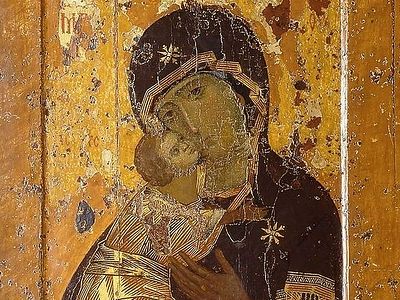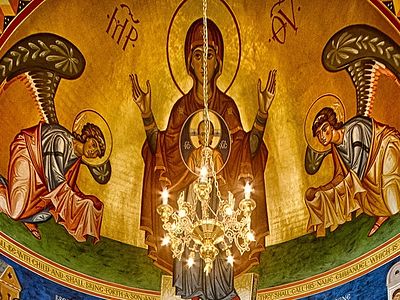Source: Loudoun Now
December 9, 2016
![Don Phillips works on a piece during an iconography class at Trinity House Café . [Danielle Nadler/Loudoun Now]](http://www.pravoslavie.ru/sas/image/102538/253886.p.jpg?mtime=1481269532) Don Phillips works on a piece during an iconography class at Trinity House Café . [Danielle Nadler/Loudoun Now]
Don Phillips works on a piece during an iconography class at Trinity House Café . [Danielle Nadler/Loudoun Now]
Colette Kalvesmaki has a fascination with the origins of things.
That passion for returning to beginnings drew her to Eastern Orthodox Christianity and to the ancient art of iconography. Kalvesmaki, who operates a gallery and teaching studio focused on Byzantine art in Washington, DC, spends every Tuesday passing on her craft to students at Leesburg’s Trinity House Café.
Head upstairs to the café’s second floor, and you’ll see Kalvesmaki’s quietly stunning Saint Peter icon. And in that same space, the artist is passing on her knowledge to a cadre of students from Loudoun, and points west for whom iconography is both an art form and a spiritual practice.
“People are starting to look at how to make things, how did we used to do things. …We’re looking back,” Kalvesmaki said when asked about the appeal of the ancient art form to contemporary students.
Religious iconography is a centuries-old practice of creating symbolic paintings of religious figures—often Christ, Mary and Christian saints and angels. The Eastern Orthodox Church has a particularly rich tradition, and Kalvesmaki said the art form is undergoing a revival as interest in the traditional process and the spiritual component of the work create new enthusiasm among artists and believers.
“People are drawn to it because they can see there’s a lot going on here,” she said.
The combination of richness and simplicity of the Eastern Christian icon is a big part of the appeal: Kalvesmaki points out that as Western religious art has changed through the ages, the Eastern icon has changed relatively little over the centuries and retains a sense of serenity and stillness often absent in Western art.
Learning the physical process of creating an icon is also part of the draw for students. Kalvesmaki handcrafts her materials—including the chalk-based material called gessa, which is used to treat the wooden boards on which icons are traditionally painted, and traditional egg tempera paint. The gilding process, an essential element of many icons, is also a painstaking process involving the application of gold leaf to a soft clay called bole.
Early iconography was primarily the work of monks who were immersed in the life of the church, and Kalvesmaki is a practicing Orthodox Christian with a theology degree. A California native, she earned a degree in classical archaeology from the University of California, Santa Barbara. A convert to evangelical Protestantism in her teens, Kalvesmaki began researching Christian history and was drawn to the Orthodox Church, going on to earn a master’s degree in theology from an Orthodox seminary in the early ’90s. During her time in the seminary, she heard about a shortage of American iconographers, but it wasn’t until a move to Boston found her living down the street from renowned Russian iconographer Ksenia Pokrovsky that she decided to take the plunge.
“I took it as a sign from God,” she said.
Kalvesmaki studied with Pokrovsky for three years and spent time in Seattle before moving to the Washington, DC area with her husband, Joel, in 2001. Joel Kalvesmaki is an editor in Byzantine studies at Dumbarton Oaks research library and museum in Washington, DC. And Colette Kalvesmaki’s Saint Peter icon on display at Trinity House Café is based on that museum’s prized 13th century Saint Peter icon. The couple now lives in Montgomery County, MD, with their two children.
Kalvesmaki said that, as there are few written teachings
on Orthodox Christian iconography, the tradition of
passing on knowledge from teacher to student has
been—and continues to be—key. She opened the
Center for Byzantine Material Arts in 2014 as a showcase
and instructional center for the DC metro area. Around the
same time, her friend Ever Johnson, founder of the John
Paul II Fellowship, opened Trinity House Café in an
18th century house in downtown Leesburg and invited
Kalvesmaki to teach classes.
“Our mission at Trinity House is to renew community
and culture, and Colette’s classes are a perfect
example of how that works practically speaking,”
Johnson said. “The ancient art of iconography can
help renew our dignity by taking time to develop personal
gifts and profound relationships in the creation of sacred
images.”
Kalvesmaki offers individual instruction every Tuesday at Trinity House Café and occasionally offers weekend workshops for beginners.
Matthew Sheffield travels from Berryville to Leesburg every week for his class with Kalvesmaki. Sheffield became interested in Eastern Christianity and iconography after reading “The Way of a Pilgrim,” a well-known anonymous 19th century works recounting the journey of a Russian religious pilgrim. Sheffield searched for iconography classes but was unable to find any close to home—until an internet search led him to a weekend workshop Kalvesmaki had scheduled at Trinity House Café last March. Sheffield is working on an icon of Saint Euphrosynos the Cook, a 9th century monk whose image is a common fixture in Orthodox Christian kitchens. He’s improving as a craftsman, he says, and also finds the practice spiritually uplifting.
“I look forward to it every week,” Sheffield said. “It’s completely enriched my own prayer life.”




